Digital Comic Series Illustrates the Stories of 10 Women Artists The Smithsonian American Art Museum has teamed up with students at the Ringling College of Art and Design to share the stories of women artists from across decades and disciplines. Drawn to Art: Ten Tales of Inspiring Women Artists is a suite of 10 comics about artists, each with artwork represented in SAAM's collection, as imagined by each student-illustrator. The entire series of compelling art and bright storytelling is available to view online. | | ||
| |
|
Showing posts with label Smithsonian American Art Museum. Show all posts
Showing posts with label Smithsonian American Art Museum. Show all posts
Tuesday, December 07, 2021
Smithsonian's webcomics Drawn to Art: Ten Tales of Inspiring Women Artists
Monday, May 16, 2016
Recalling Darwyn Cooke's 2010 appearance at the Smithsonian
by Mike Rhode
Darwyn Cooke has been one of my favorite comic book artists for about a decade and a half. He passed away over the weekend.
Darwyn Cooke has been one of my favorite comic book artists for about a decade and a half. He passed away over the weekend.
I had forgotten that I had written about a talk he gave at the Smithsonian American Art Museum. It doesn't seem to be online at their site anymore, so I'll reproduce it here. Also, you can hear my recording of the talk here, newly online since sadly we won't be able to hear any new thoughts from him.
(I didn't write that lede by the way)
by Mike Rhode Washington City Paper blog Feb. 3, 2010
Sure, the crowd was thin due to the snow. But the air was thick with nuggets: Darwyn Cooke spoke for almost two hours to a rapt crowd of about 40 people at the Smithsonian's American Art Museum Saturday, concentrating on his recent adaptation of Richard Stark's novel Parker: The Hunter and offering a glimpse into the mind of a successful, critically adored cartoonist. Just don't, he said, call him a creator. Cooke would rather be known, simply, as someone who entertains, and that's exactly what he did at Saturday's event. Read some of his more memorable quotes:
"I was pretty sure the Smithsonian called the wrong number when they approached me about this program, but I jumped at the chance to come down to talk about Don Westlake [aka Richard Stark] and Parker—two of my favorite subjects."
"The [Parker] books are very lean and brutal and I think that's part of what I loved about them…."
"I have to plan everything. I have to write biographies of all my characters, I have to research every scene and situation, and then I have to outline it in great detail in order for me to feel secure enough to go ahead with the work…" in contrast to Westlake's lack of plotting, backstory or details about Parker's life.
"The Hunter was written in 1962, which was actually the year I was born, which I thought was kind of neat."
"When I was a kid, I used to love series novels, like The Executioner, and all these sort of terrible B-movie type paperbacks…. but as I got older I realized that the quality of the writing in them was terrible and I moved on to more literate fare."
"[Westlake] was able to keep [Parker] completely reprehensible, and yet completely magnetic. He's certainly not a person you'd want to have to deal with in your life, but he's a very interesting, very magnetic type of character."
"Parker as a character represents something that we've seen evaporate from the American landscape over the last century and it's probably the last period of time when a character like this could have existed—that's basically a free-market anarchist. A man who makes his own rules, lives by his own rules, his own judgments and society still has room for him to operate within."
"The only thing I can compare [the plot] to is, you know when you get a phone bill for $500 for one month, and it's a mistake and you phone the phone company to get it straightened out? That's what he goes through. That's what this book is—it's a man who got screwed and is trying to communicate through a large faceless corporation that he's been screwed and he's owed something and the frustration that comes out of that. When you consider the time that the book was written, I think it's a very sly sort of indictment of the world we were all looking into."
"What can I do to reach outside the comic book audience… How can I get outside this [direct] market? How can I reach other readers with my work? The only real viable option at the time was the idea of original graphic novels. I very quickly set my sights there. … It's still a very risky creative venture. To put out an original graphic novel and hope it finds an audience is a very risky venture. We've seen some incredible books in the last few years, whether it's Persepolis, or Asterios Polyp or Diary of Wimpy Kid or American Born Chinese. These are all graphic novels that have nothing to do with superheroes…but they all have audiences that responded to the stories within the books. That really gave me the juice and the excitement to move forward…"
"DC had contacted me about doing Will Eisner's The Spirit. As much I was ready to move on, they found the one project that would keep me there. I hope this doesn't sound the wrong way, but half the reason I wanted to do this project was to make sure it didn't get screwed up by somebody else. It was purely a defensive position I was taking around the character… That was a hard year trying to live up to Will's work and deal with that character and everything it meant, so I was really thrilled when it was over…"
"At the time I started to correspond with Westlake, he was 72 years old, but his enthusiasm for this was unbelievable…"
"As for as he was concerned, if I screwed up [the adaptation], it didn't matter. Because the book's still there."
On having difficulties with character design and not receiving guidance from Westlake: "Finally I forced him into laying it out. '[Parker] is Jack Palance. It's Jack Palance from a movie called Panic in the Streets. That's what I saw in my head when I wrote it.' So from that point on I was able to fashion a character and an approach that Donald was really thrilled by."
Cooke planned on submitting the book to Westlake for Christmas, but Westlake went on vacation and died before Cooke sent it to him. "He never got to see any of it and it took about six weeks to get back to work. It really stopped me in my tracks and I realized that I'd been doing it for an audience of one person and that audience was gone. I didn't even know why I was doing the book for a little while after that."
At this point, Cooke read from the actual novel while showing the first chapter of his adaption on the screen.
"Those of you familiar with my earlier work should know I'm pretty plugged into the 'heroic ideal' and I love the notion of optimism and hope and I'd like to think that most of my work carries those messages right up front and this was a case I had to put all my instincts aside and sort of go more with Donald's."
"Nothing was better back then [in 1962] except the way things looked…"
"Anything I could do visually to immerse us in—to make us feel that we were back in that time period—was gonna help people get into the book. Everything in here was done with the tools available in 1962. There's no computer lettering, there's no digital tinting. It's drawn on the art board, the black ink is laid down, the lettering is laid down, and then I take a blue watercolor and lay it right onto the board. Nobody does this anymore…I even had the printers lay a pale yellow ink on top of every page before the artwork went down so that the book even had the appearance of being yellowed with age…"
"I'm hard at work on the second book now, about halfway through. It's called The Outfit and that's going to be out in October…I'm doing four [adaptations]."
"I've never been comfortable with the terms 'artist' or 'creator.' I think they're bullshit terms that are thrown around to make the guys who do the work feel better about themselves. For example, Jack Kirby was a creator. Jack Kirby created entire universes. Ethan Van Sciver pencils a comic book—there's a big difference there. I've always been very uncomfortable when people referred to me as a creator…I've always preferred entertainer, or storyteller. Those I'm much prouder of, or more comfortable with those designations. I'm not that deep. I'm just not."
"I love stories about people who've found ways to live without having to suck up to The Man."
"Heroes aren't heroes anymore; they're just people with power. And I think that it's a shame."
Sunday, July 04, 2010
Post and Times on Norman Rockwell exhibit
I'm of two minds about Rockwell, but I think if you approach him as a consummate illustrator, as Solomon does, you can enjoy his work more than if you worry about putting him into an artistic pantheon at the moment.
Norman Rockwell exhibit opens at the Smithsonian American Art Museum, By Blake Gopnik, Washington Post Sunday, July 4, 2010; E01. There are 86 comments now on this one mostly bashing Gopnik.
America, Illustrated, By DEBORAH SOLOMON, New York Times July 4, 2010
Norman Rockwell exhibit opens at the Smithsonian American Art Museum, By Blake Gopnik, Washington Post Sunday, July 4, 2010; E01. There are 86 comments now on this one mostly bashing Gopnik.
America, Illustrated, By DEBORAH SOLOMON, New York Times July 4, 2010
Wednesday, February 03, 2010
The Quotable Darwyn Cooke up at City Paper
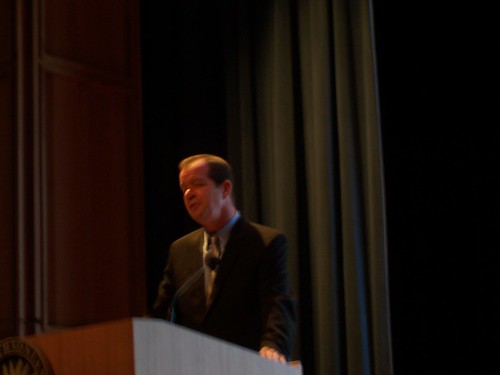
See my The Quotable Darwyn Cooke: Highlights from the Cartoonist’s Talk at American Art, by Mike Rhode on Feb. 3, 2010 at the City Paper for some of the interesting things the cartoonist said, and here's a few of my pictures as well.

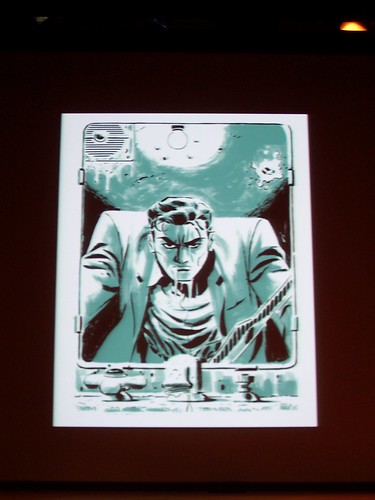

Friday, January 29, 2010
Cooke interview at Smithsonian American Art blog
There's a Darwyn Cooke interview at the Smithsonian Magazine's blog for his appearance at American Art tomorrow. I'll be there - anyone else?
Wednesday, January 20, 2010
Darwyn Cooke's appearance at American Art PR
Darwyn Cooke's appearance at American Art on January 30th has PR hitting the comics sites now. Except for mine. IDW doesn't love me.
Friday, January 08, 2010
Jan 30: Darwyn Cooke at American Art
Here's a reminder post, based on the DC Examiner mentioning it today.
Saturday January 30, 2010
The Hunter with Darwyn Cooke Lectures & Seminars
4:00 PM
McEvoy Auditorium, Lower Level
American Art Museum
Eisner Award–winning writer and artist Darwyn Cooke will discuss his evocative graphic novel, The Hunter, based on the 1962 crime classic by Donald E. Westlake (writing under the name Richard Stark). This best seller has been critically acclaimed in The New York Times, The Los Angeles Times, and The Washington Post for breathing new life into one of the classic characters of crime fiction. With a visual style that both pays homage to and plays with ‘60s retro style, The Hunter vividly depicts the film noir genre.
Limited free tickets (two per person), G Street Lobby, one hour prior. Book signing follows.
McEvoy Auditorium, Lower Level
Saturday January 30, 2010
The Hunter with Darwyn Cooke Lectures & Seminars
4:00 PM
McEvoy Auditorium, Lower Level
American Art Museum
Eisner Award–winning writer and artist Darwyn Cooke will discuss his evocative graphic novel, The Hunter, based on the 1962 crime classic by Donald E. Westlake (writing under the name Richard Stark). This best seller has been critically acclaimed in The New York Times, The Los Angeles Times, and The Washington Post for breathing new life into one of the classic characters of crime fiction. With a visual style that both pays homage to and plays with ‘60s retro style, The Hunter vividly depicts the film noir genre.
Limited free tickets (two per person), G Street Lobby, one hour prior. Book signing follows.
McEvoy Auditorium, Lower Level
Thursday, December 10, 2009
Cartoonists' Christmas cards on display? UPDATED
An article in today's Express mentions cartoonists as being included in the Season's Greetings exhibit at the Archives of American Art in the American Art building on 9th and F Sts, NW. If anyone beats me to the exhibit, let us know who's in the show, since the website doesn't.
In the comments, we are informed (presumably by an AAA staff member):
Al Freuh
Ralph Fabri
Harry Haenigsen
Frances Foot
Janet LaSalle
Norman Kent
Everett Charles Hart
Michael Ponce de León
Boris Artzybasheff
Harrison Cady
Walt Kuhn
Ralph Barton
Ad Reinhardt
In the comments, we are informed (presumably by an AAA staff member):
Al Freuh
Ralph Fabri
Harry Haenigsen
Frances Foot
Janet LaSalle
Norman Kent
Everett Charles Hart
Michael Ponce de León
Boris Artzybasheff
Harrison Cady
Walt Kuhn
Ralph Barton
Ad Reinhardt
Wednesday, February 18, 2009
April 26: Roz Chast at Smithsonian
Another tip from Herschel:
Roz Chast, Harold Holzer, Jamaica Kincaid and John Waters Participate in Second Annual Lecture Series
WASHINGTON, DC.- This spring, the Smithsonian’s National Portrait Gallery and the Smithsonian American Art Museum, in partnership with Washington College in Chestertown, Md., present the second annual “American Pictures Distinguished Lecture Series.” The 2009 series speakers are Roz Chast, internationally recognized cartoonist for the New Yorker; leading Lincoln scholar Harold Holzer; critically acclaimed novelist Jamaica Kincaid; and actor, writer, visual artist and filmmaker John Waters.
“American Pictures” pairs great works of art with pre-eminent figures of contemporary American culture. Each lecture features a writer, critic, historian or artist who chooses a single image and investigates its meanings. In the process, the speaker also explores how works of art inspire creativity in many different fields and reveal American identity or a shared history. The series director is historian and essayist Adam Goodheart, who is director of the C.V. Starr Center for the Study of the American Experience at Washington College.
The series debuts Saturday, March 21, when Waters offers his insights into Cy Twombly’s drawing “Letter of Resignation” (1967). Kincaid will discuss the painting “Kept In” (1889) by Edward Lamson Henry Saturday, April 11. Holzer will examine John Henry Brown’s portrait of Abraham Lincoln (1860) Saturday, April 18. The 2009 series concludes Sunday, April 26, with Chast’s exploration of Charles Addams’s famous cartoon “Boiling Oil” (1946).
Additional information about the series and the speakers is available online at americanart.si.edu and npg.si.edu or in a printed brochure that is available at the museums’ information desks.
“American Pictures” is made possible through the pioneering partnership among Washington College, the National Portrait Gallery and the Smithsonian American Art Museum. Additional support comes from the Starr Foundation, the Hodson Trust, the Hedgelawn Foundation and other donors.
Roz Chast, Harold Holzer, Jamaica Kincaid and John Waters Participate in Second Annual Lecture Series
WASHINGTON, DC.- This spring, the Smithsonian’s National Portrait Gallery and the Smithsonian American Art Museum, in partnership with Washington College in Chestertown, Md., present the second annual “American Pictures Distinguished Lecture Series.” The 2009 series speakers are Roz Chast, internationally recognized cartoonist for the New Yorker; leading Lincoln scholar Harold Holzer; critically acclaimed novelist Jamaica Kincaid; and actor, writer, visual artist and filmmaker John Waters.
“American Pictures” pairs great works of art with pre-eminent figures of contemporary American culture. Each lecture features a writer, critic, historian or artist who chooses a single image and investigates its meanings. In the process, the speaker also explores how works of art inspire creativity in many different fields and reveal American identity or a shared history. The series director is historian and essayist Adam Goodheart, who is director of the C.V. Starr Center for the Study of the American Experience at Washington College.
The series debuts Saturday, March 21, when Waters offers his insights into Cy Twombly’s drawing “Letter of Resignation” (1967). Kincaid will discuss the painting “Kept In” (1889) by Edward Lamson Henry Saturday, April 11. Holzer will examine John Henry Brown’s portrait of Abraham Lincoln (1860) Saturday, April 18. The 2009 series concludes Sunday, April 26, with Chast’s exploration of Charles Addams’s famous cartoon “Boiling Oil” (1946).
Additional information about the series and the speakers is available online at americanart.si.edu and npg.si.edu or in a printed brochure that is available at the museums’ information desks.
“American Pictures” is made possible through the pioneering partnership among Washington College, the National Portrait Gallery and the Smithsonian American Art Museum. Additional support comes from the Starr Foundation, the Hodson Trust, the Hedgelawn Foundation and other donors.
Sunday, June 03, 2007
Fun times with Bob Mankoff

Bob Mankoff gave a very interesting talk today at the Smithsonian American Art Museum as part of their Steinberg exhibit. The talk was held in the lovely new auditorium apparently buried under the former courtyard. Mr. Mankoff talked about Steinberg's early cartoons for the New Yorker (which can be seen on the Complete New Yorker Cartoons cd), Steinberg's influence on his early work, and the nature of gag cartoons and humor. Mankoff said that the Caption Contest gets about 10,000 entries per week and showed a slide of how he and his assistants break up the entries to make sense of them. He had a lot of interesting points to make, and the working cartoonists I was sitting with, AAEC head Rob Rogers, Matt Wuerker, Nick Galifianakis and Richard Thompson all seemed engaged. I certainly was, but I'm not a professional cartoonist.
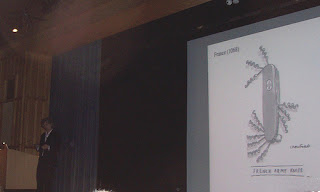 Crawford cartoon to illustrate the nature of humor.
Crawford cartoon to illustrate the nature of humor. Some of the 10,000 entries to the New Yorker Cartoon Contest sorted into categories.
Some of the 10,000 entries to the New Yorker Cartoon Contest sorted into categories.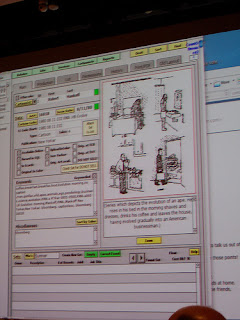 Sample page of Cartoon Bank database.
Sample page of Cartoon Bank database.Afterwards Mr. Mankoff signed books including the New Yorker Book of Art Cartoons. In the accompanying pictures (below), Warren Bernard gets confirmation that four books is the complete set of Mankoff books, and gets them all signed at one fell swoop. Mankoff said that he didn't even have copies of them all anymore.


The rain started in earnest so Rob Rogers invited Mr. Mankoff to the museum's cafe with us and we had a fun hour hearing stories of the New Yorker, and talking shop. Matt stood us all to drinks, and Rob picked up the chips - thanks guys! One point Mankoff did make was that by animating cartoons, the Cartoon Bank could pick up new sponsors like Lexus - here's an example that Richard found.
 Rob Rogers, Matt Wuerker, Bob Mankoff, Richard Thompson and Nick Galifianakis talking in the museum lobby after the booksigning.
Rob Rogers, Matt Wuerker, Bob Mankoff, Richard Thompson and Nick Galifianakis talking in the museum lobby after the booksigning.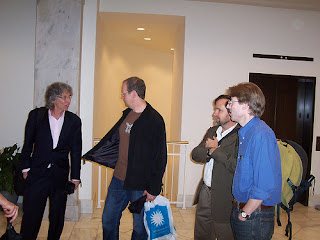 Rob Rogers forcibly suggests that Bob Mankoff might not want to go out in that rain.
Rob Rogers forcibly suggests that Bob Mankoff might not want to go out in that rain.The last two photos are everyone in the cafe. Richard's in the blue denim shirt, Nick's in blue shirt with long hair, Matt's in the brown jacket, Rob's in the dark blue jacket and Bob Mankoff's in the suit. This was a thoroughly enjoyable Sunday. Matt wrote down the best epigraphs from the talk, and hopefully one of the others will flesh out this entry a bit.


Thursday, May 31, 2007
June 3: Bob Mankoff at American Art
New Yorker cartoonist and comics editor Bob Mankoff will be at the Saul Steinberg exhibit at the Smithsonian American Art Museum. The free program is at 3 pm on Sunday
Saturday, May 05, 2007
Washington Times reviews Steinberg exhibit
"Illuminating images, words, wit and genius" By Joanna Shaw-Eagle, Washington Times May 5, 2007. There's also an amusing article on Spider-Man 3 tchotkes -
"Spider-Man battles foes on many toy land fronts" By Joseph Szadkowski, Washington Times May 5, 2007. I've got my Spider-Spud!
"Spider-Man battles foes on many toy land fronts" By Joseph Szadkowski, Washington Times May 5, 2007. I've got my Spider-Spud!
Saturday, April 14, 2007
Steinberg exhibit review in today's Examiner
Unfortunately, it's not online so if you want to read it, you'll have to find a copy of the paper.
I'll try to follow up my initial Steinberg report later today.
I'll try to follow up my initial Steinberg report later today.
Subscribe to:
Posts (Atom)
